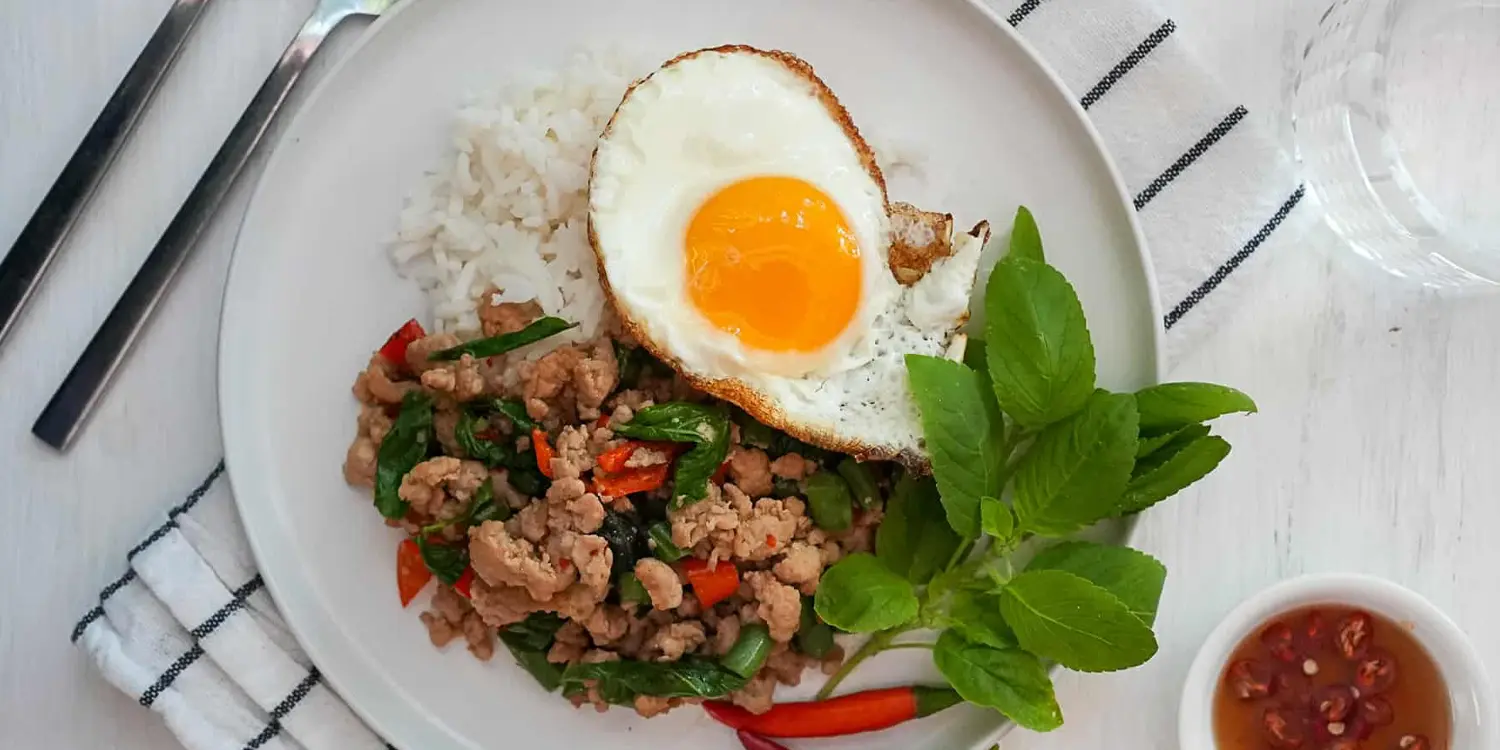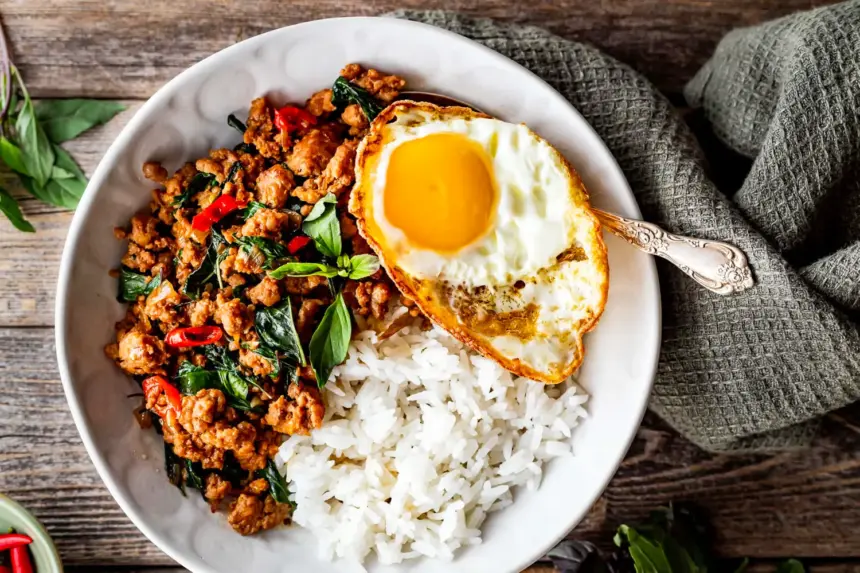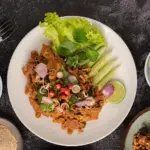The Unofficial National Dish: Your Ultimate Guide to Authentic Pad Kra Pao
If there is one dish that truly captures the fiery, fast-paced, and utterly addictive spirit of Thailand, it’s Pad Kra Pao (ผัดกะเพรา). This isn’t just a stir-fry; it is the reigning champion of Thai street food, the ultimate comfort meal, and the dish you’ll see locals devour morning, noon, and night.
Pronounced Pad Gap-ow, this bold and aromatic plate of minced meat and holy basil, fiercely stir-fried and served over rice with a crispy fried egg, is a symphony of flavor: salty, spicy, savory, and powerfully fragrant. It’s a dish that demands attention, thanks to its distinct pepperiness and incredible speed of preparation.
While it seems simple, achieving the perfect Pad Kra Pao requires understanding a few crucial secrets, the most important being the difference between Thai holy basil and common sweet basil. Whether you’re a seasoned chef or a home cook looking for a weeknight adventure, this is your definitive guide to mastering Thailand’s most beloved, boldest, and fastest stir-fry. Get ready to turn up the heat and bring the authentic taste of a Bangkok street corner into your own kitchen!

Pad Kra Pao: More Than Just Food, It’s Culture
To understand why Pad Kra Pao is so essential, you have to understand its place in Thai society. It’s the “What should I eat?” answer for millions of Thais every single day.
The Go-To Order
Go to any Thai food stall, and you will see the wok master (or Ahaan) constantly preparing this dish. It’s the Thai equivalent of a bacon cheeseburger—familiar, fast, customizable, and endlessly satisfying. Its simplicity is its strength: a few core ingredients cooked over screaming-hot heat to maximize flavor in minutes. When Thais can’t decide what to eat, they default to Pad Kra Pao. When they need a reliable, quick, and powerful flavor punch, they order Pad Kra Pao. It is, without a doubt, the unofficial national dish.
The Anatomy of a Perfect Plate
A true plate of Pad Kra Pao consists of three non-negotiable elements that create perfect harmony:
- The Stir-fry: Bold, aromatic, and spicy, often dry (less sauce) to ensure maximum heat and flavor concentration.
- The Rice: Steaming hot, fluffy Jasmine rice to absorb the savory sauce and provide the necessary balance against the heat.
- The Egg: A crispy, high-heat fried egg with a runny yolk (Khai Dao) to add richness and temper the chili fire.
The Holy Grail of Herbs: Finding Authentic Kra Pao
If there is one piece of advice to take away, it is this: You must use Holy Basil to make authentic Pad Kra Pao. The confusion surrounding basil is the single biggest reason why Pad Kra Pao made outside of Thailand often tastes like a different dish entirely (usually Pad See Ew or a general stir-fry).
Kra Pao vs. Horapha vs. Maenglak
Thai cuisine uses several types of basil, each with a unique flavor profile. To get Pad Kra Pao right, you need the right one.
| Name | Thai Name | Flavor Profile | Use |
| Holy Basil | Kra Pao | Peppery, slightly spicy, with notes of anise and clove. Extremely potent and assertive. | The ONLY basil for Pad Kra Pao. |
| Thai Sweet Basil | Horapha | Sweet, licorice-like flavor. Mild and sweeter than Holy Basil. | Used in curries (like Green Curry) and fresh spring rolls. |
| Lemon Basil | Maenglak | Strong lemon scent. | Primarily used in specific regional curries and seafood dishes. |
The Bottom Line: If you cannot find fresh Holy Basil (Kra Pao), most purists would argue it is better to skip the dish than to use sweet basil. Sweet basil will yield a delicious stir-fry, but it will not taste like authentic Pad Kra Pao. Look for Holy Basil at specialized Asian markets—it’s worth the hunt!
The Authentic Pad Kra Pao Recipe (Minced Pork)
This recipe focuses on the traditional Moo Sap (minced pork) version, cooked dry for maximum flavor punch, and includes the secret ingredient for authentic umami depth.
Ingredients List
| Component | Item | Quantity | Notes |
| Protein | Minced Pork (Moo Sap) | 300g (10.5 oz) | Traditionally pork shoulder or beef (Nuea Sap). |
| Aromatics | Garlic | 5 cloves | Must be smashed or pounded. |
| Thai Bird’s Eye Chilies | 4–6 (or to taste) | Sliced or pounded—the more you pound, the hotter it gets! | |
| The Star | Fresh Holy Basil Leaves | 1 packed cup | Essential for authenticity. |
| Sauce Blend | Oyster Sauce | 1 Tbsp | Provides richness and viscosity. |
| Light Soy Sauce | 1 Tbsp | For saltiness. | |
| Dark Soy Sauce | 1 Tbsp | For color (optional, but adds depth). | |
| Fish Sauce | 1 tsp | The unmistakable taste of Thailand. | |
| Sugar | 1/2 tsp | To balance the spice and salt. | |
| Golden Mountain Sauce (or Maggi) | 1 tsp | The Thai street food secret for umami. | |
| Garnish | Vegetable Oil (high smoke point) | 2–3 Tbsp | Essential for high-heat cooking. |
| Egg | 1 per serving | For the mandatory crispy Khai Dao. | |
| Long Beans (optional) | 1/2 cup chopped | Added for texture (purists will omit). |
Step-by-Step Wok Technique
The key to Pad Kra Pao is speed and heat. Have all ingredients prepped and near the wok before you begin.
- Prep the Aromatics (Pound for Power): In a mortar and pestle, coarsely pound the garlic and chilies into a rough mash. This releases maximum flavor and fragrance. Do not mince them finely; smashing is key.
- Mix the Sauce: Combine all sauce ingredients (oyster sauce, soy sauces, fish sauce, Golden Mountain, sugar) in a small bowl. Stir until the sugar dissolves.
- Wok to High Heat: Heat your wok or large frying pan over medium-high heat until it begins to smoke slightly. Add 1–2 Tbsp of oil.
- Stir-Fry Aromatics (30 Seconds): Add the pounded garlic and chilies. Stir constantly for about 30 seconds until highly fragrant. Do not let them burn; burning the garlic will ruin the dish.
- Cook the Protein: Add the minced pork, breaking it up quickly with your spatula. Stir-fry until the meat is no longer pink and begins to brown slightly. (If using optional long beans, add them here and cook for 1 minute.)
- Sauce and Sear: Pour the prepared sauce blend over the meat. Stir well to coat everything, letting the sauce reduce slightly and caramelize onto the meat for 1-2 minutes. This is where the flavor locks in.
- Basil Blitz (Residual Heat): Turn off the heat completely. Add the Holy Basil leaves immediately. Toss vigorously with the meat. The residual heat of the wok and meat is enough to wilt the basil just perfectly, preserving its vibrant green color and powerful aroma.
- The Khai Dao (Fried Egg): In a separate small pan, heat 1 Tbsp of oil over high heat. Once the oil is shimmering, gently crack the egg into the pan. Baste the top of the egg with the hot oil until the edges are crispy and brown, but the yolk remains runny.
- Serve: Spoon the piping-hot Pad Kra Pao over a fresh mound of Jasmine rice and top immediately with the Khai Dao (crispy fried egg).
Mastering the Details: Tips for Home Cooks
Achieving that authentic street-food flavor at home requires compensating for the lack of a commercial-grade burner.
High Heat is Non-Negotiable
Pad Kra Pao is designed for speed. When cooking at home, use your largest burner and let your wok or pan get as hot as possible before adding the oil. High heat ensures the meat sears immediately, locking in flavor and preventing the dish from steaming or stewing. Stir quickly and constantly to avoid burning while maximizing the char.
Why Pounding is Superior to Mincing
Slicing or mincing the garlic and chili keeps their cell walls relatively intact. Pounding (or crushing) the aromatics in a mortar and pestle breaks down the cell walls completely. This releases maximum essential oils and moisture, leading to a far more intense, authentic, and fragrant flavor explosion when they hit the hot oil. This step is a small effort with huge rewards.
The Sauce Debate: Wet vs. Dry
You will encounter two styles of Pad Kra Pao in Thailand:
- Dry (Mai Mee Naam): This version uses minimal to no water in the sauce, resulting in a dark, intensely flavored, and slightly caramelized meat with maximum heat. This is generally the preferred authentic street style.
- Wet (Mee Naam): This version adds a small splash of water (as listed optionally in our recipe) to create a bit of gravy. Some prefer this for coating the rice, but it slightly dilutes the flavor impact.
Stick to the dry version for your first attempt to experience the true Kra Pao intensity.
Customizing Your Pad Kra Pao Experience
One of the reasons this dish is so popular is its adaptability. Here’s how to tailor it to your preferences:
Protein Power: What to Choose
- Moo Sap (Minced Pork): The classic, most traditional choice. Its fat content ensures the dish remains juicy and full of flavor.
- Gai Sap (Minced Chicken): A leaner, healthier alternative, equally popular.
- Nuea Sap (Minced Beef): Provides a bolder, deeper flavor, often served with more heat.
- Vegetarian: Use crumbled firm tofu or finely chopped Shiitake mushrooms. Ensure you press the tofu well to remove excess moisture before cooking.
Spice Level: How Hot is Too Hot?
The heat comes primarily from the Thai Bird’s Eye Chilies. If you want a full-flavor experience without the scorching heat:
- Reduce the Chilies: Only use 1-2 chilies, or use a larger, milder red chili variety.
- Remove Seeds: Removing the seeds from the chilies before pounding dramatically reduces the heat while preserving the chili’s flavor.
To Vegetable or Not to Vegetable?
The purists are right: the true flavor of Pad Kra Pao relies solely on the power of the holy basil and chili. However, many modern Thai cooks add vegetables for texture and nutrition.
- Acceptable Additions: A handful of chopped long beans (as listed in our recipe) or finely chopped bell peppers.
- Avoid: Large quantities of watery vegetables like sliced onions or cabbage, as they release too much moisture and dilute the crucial dry, intense flavor of the stir-fry.
The Finishing Touch: Why the Fried Egg is Mandatory
The crispy fried egg, or Khai Dao, is not optional—it is the essential ingredient that completes the dish.
The Art of the Khai Dao
The perfect Khai Dao has two distinct textures:
- Crispy White: The edges of the egg white should be lacy, golden-brown, and crispy, achieved by frying in very hot oil.
- Runny Yolk: The yolk must remain liquid and warm. When broken, it coats the spicy, savory meat and rice, adding a layer of creamy, rich flavor that instantly tames the chili heat.
To achieve this, use slightly more oil than normal and let it get hot before you add the egg. Spoon the hot oil over the white until it sets, then remove quickly.
Troubleshooting and FAQs
| Problem | Cause | Solution |
| It Tastes Too Sweet | Too much dark soy sauce or palm sugar in the sauce blend. | Add a splash of fish sauce (saltiness) or lime juice (sourness) to the finished dish. |
| It’s Too Watery | The wok wasn’t hot enough, or you added too many vegetables. | Cook the meat until completely dry before adding the sauce. If liquid forms, remove the meat, reduce the liquid, and add the meat back in. |
| It Doesn’t Taste Right | You used sweet basil (Horapha) instead of Holy Basil (Kra Pao). | This is the biggest hurdle. The only fix is to find authentic Holy Basil for your next batch. |
Pad Kra Pao is the kind of recipe that rewards courage and practice. Don’t be afraid of the heat, embrace the chaos of the high-heat stir-fry, and respect the unique power of the Holy Basil. Once you master this dish, you’ll have unlocked one of the most rewarding and satisfying culinary secrets Thailand has to offer. Enjoy!













